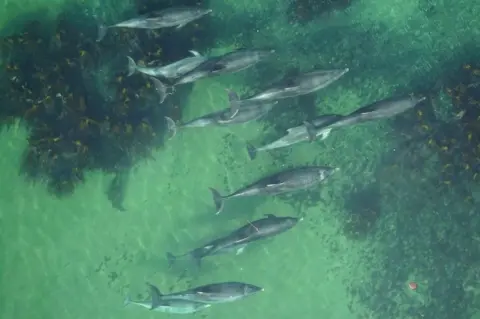Drones used to see if dolphins are pregnant
 University of Aberdeen
University of AberdeenDrones can successfully be used to see if dolphins are pregnant, researchers have said.
A team from the University of Aberdeen found measuring the body width captured in aerial images could establish which females were expecting.
Previously, only successful pregnancies were known about when dolphins were were seen with a calf.
The study was carried out by researchers based at the university's Cromarty Lighthouse Field Station.
Scientists from the university have spent more than 30 years monitoring the bottlenose dolphin population that uses the Moray Firth Special Area of Conservation.
The research was in collaboration with Duke University in America and its Marine Robotics and Remote Sensing Laboratory (MaRRS) and has been described as the first to non-invasively establish whether protected female bottlenose dolphins are pregnant.
For this study, the aerial images were compared with information from the long-term information gathered, including whether the females had had a calf and their age.
 Getty Images
Getty ImagesThe University of Aberdeen's Dr Barbara Cheney said: "We only knew about successful pregnancies, and didn't know how many pregnancies failed or how many calves died before we saw them.
"The main aim of the study was to explore whether we could remotely determine pregnancy status from aerial photographs taken using an unoccupied aerial system or drone.
"Similar studies have been carried out for larger whales but as far as we know this is the first time it has been done for small cetaceans."
'Wealth of new data'
It is hoped researchers can gather data on failed pregnancies which could provide information on an individual's health and help identify the causes of changes in the population, such as lack of food.
Dr Cheney said: "By using aerial photos this will allow us to routinely monitor changes in reproductive success in this protected bottlenose dolphin population, supporting conservation.
"Data on failed pregnancies could provide information on how healthy a particular dolphin is as well as helping to identify the causes of changes in the population.
"Gathering Information is also particularly challenging in cetaceans that are highly mobile and spend much of their time underwater. This study will provide us with a wealth of new data to further improve our knowledge and understanding of reproductive success in bottlenose dolphins."
The research has been published in Remote Sensing in Ecology and Conservation.
